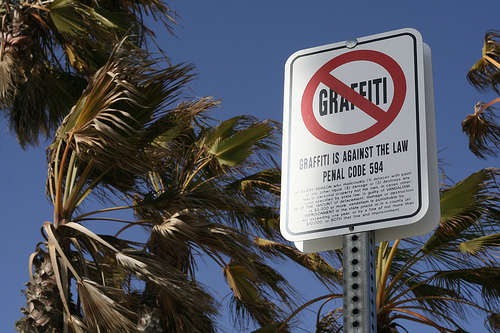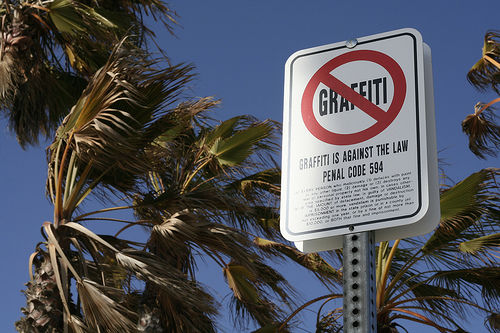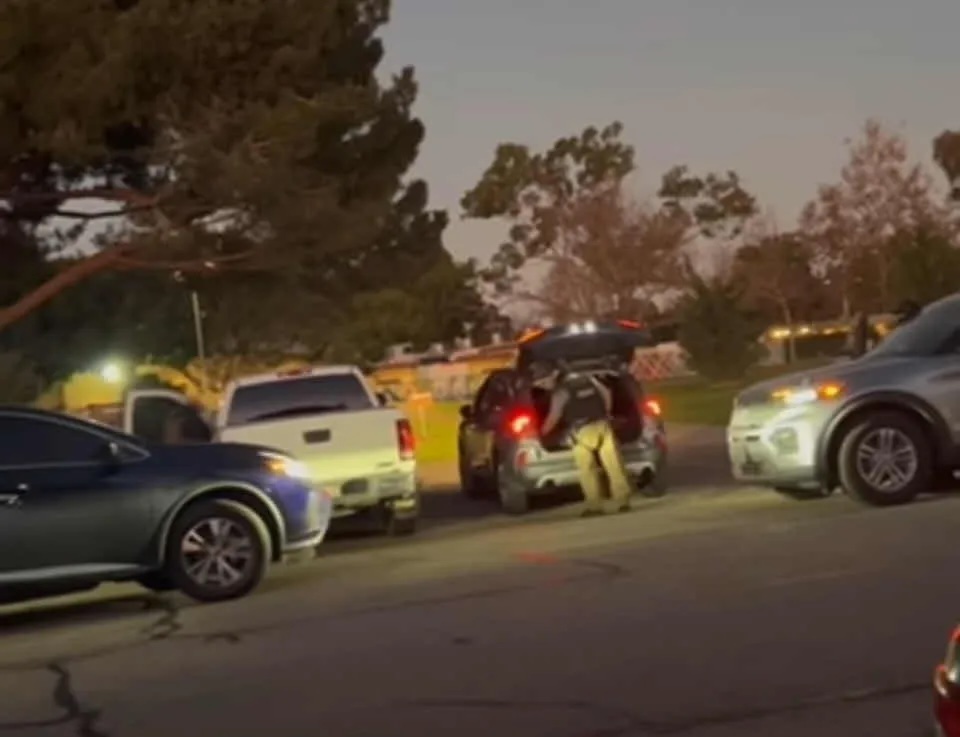
Sign in Venice Beach, Photo by Bubble Boy
594. (a) Every person who maliciously commits any of the following
acts with respect to any real or personal property not his or her
own, in cases other than those specified by state law, is guilty of
vandalism:
(1) Defaces with graffiti or other inscribed material.
(2) Damages.
(3) Destroys.
Whenever a person violates this subdivision with respect to real
property, vehicles, signs, fixtures, furnishings, or property
belonging to any public entity, as defined by Section 811.2 of the
Government Code, or the federal government, it shall be a permissive
inference that the person neither owned the property nor had the
permission of the owner to deface, damage, or destroy the property.
(b) (1) If the amount of defacement, damage, or destruction is
four hundred dollars ($400) or more, vandalism is punishable by
imprisonment in the state prison or in a county jail not exceeding
one year, or by a fine of not more than ten thousand dollars
($10,000), or if the amount of defacement, damage, or destruction is
ten thousand dollars ($10,000) or more, by a fine of not more than
fifty thousand dollars ($50,000), or by both that fine and
imprisonment.
(2) (A) If the amount of defacement, damage, or destruction is
less than four hundred dollars ($400), vandalism is punishable by
imprisonment in a county jail not exceeding one year, or by a fine of
not more than one thousand dollars ($1,000), or by both that fine
and imprisonment.
(B) If the amount of defacement, damage, or destruction is less
than four hundred dollars ($400), and the defendant has been
previously convicted of vandalism or affixing graffiti or other
inscribed material under Section 594, 594.3, 594.4, 640.5, 640.6, or
640.7, vandalism is punishable by imprisonment in a county jail for
not more than one year, or by a fine of not more than five thousand
dollars ($5,000), or by both that fine and imprisonment.
(c) Upon conviction of any person under this section for acts of
vandalism consisting of defacing property with graffiti or other
inscribed materials, the court may, in addition to any punishment
imposed under subdivision (b), order the defendant to clean up,
repair, or replace the damaged property himself or herself, or order
the defendant, and his or her parents or guardians if the defendant
is a minor, to keep the damaged property or another specified
property in the community free of graffiti for up to one year.
Participation of a parent or guardian is not required under this
subdivision if the court deems this participation to be detrimental
to the defendant, or if the parent or guardian is a single parent who
must care for young children.
(d) If a minor is personally unable to pay a fine levied for acts
prohibited by this section, the parent of that minor shall be liable
for payment of the fine. A court may waive payment of the fine, or
any part thereof, by the parent upon a finding of good cause.
(e) As used in this section, the term "graffiti or other inscribed
material" includes any unauthorized inscription, word, figure, mark,
or design, that is written, marked, etched, scratched, drawn, or
painted on real or personal property.
(f) The court may order any person ordered to perform community
service or graffiti removal pursuant to paragraph (1) of subdivision
(c) to undergo counseling.
(g) This section shall become operative on January 1, 2002.
594.1. (a) (1) It shall be unlawful for any person, firm, or
corporation, except a parent or legal guardian, to sell or give or in
any way furnish to another person, who is in fact under the age of
18 years, any etching cream or aerosol container of paint that is
capable of defacing property without first obtaining bona fide
evidence of majority and identity.
(2) For purposes of this section, "etching cream" means any
caustic cream, gel, liquid, or solution capable, by means of a
chemical action, of defacing, damaging, or destroying hard surfaces
in a manner similar to acid.
(3) For purposes of this subdivision, "bona fide evidence of
majority and identity" is any document evidencing the age and
identity of an individual which has been issued by a federal, state,
or local governmental entity, and includes, but is not limited to, a
motor vehicle operator's license, a registration certificate issued
under the federal Selective Service Act, or an identification card
issued to a member of the armed forces.
(4) This subdivision shall not apply to the furnishing of six
ounces or less of etching cream or an aerosol container of paint to a
minor for the minor's use or possession under the supervision of the
minor's parent, guardian, instructor, or employer.
(5) Etching cream, aerosol containers of paint, or related
substances may be furnished for use in school-related activities that
are part of the instructional program when used under controlled and
supervised situations within the classroom or on the site of a
supervised project. These containers may not leave the supervised
site and shall be inventoried by the instructor. This use shall
comply with Section 32060 of the Education Code regarding the safe
use of toxic art supplies in schools.
(b) It shall be unlawful for any person under the age of 18 years
to purchase etching cream or an aerosol container of paint that is
capable of defacing property.
(c) Every retailer selling or offering for sale in this state
etching cream or aerosol containers of paint capable of defacing
property shall post in a conspicuous place a sign in letters at least
three-eighths of an inch high stating: "Any person who maliciously
defaces real or personal property with etching cream or paint is
guilty of vandalism which is punishable by a fine, imprisonment, or
both."
(d) It is unlawful for any person to carry on his or her person
and in plain view to the public etching cream or an aerosol container
of paint while in any posted public facility, park, playground,
swimming pool, beach, or recreational area, other than a highway,
street, alley, or way, unless he or she has first received valid
authorization from the governmental entity which has jurisdiction
over the public area.
As used in this subdivision, "posted" means a sign placed in a
reasonable location or locations stating it is a misdemeanor to
possess etching cream or a spray can of paint in that public
facility, park, playground, swimming pool, beach, or recreational
area without valid authorization.
(e) (1) It is unlawful for any person under the age of 18 years to
possess etching cream or an aerosol container of paint for the
purpose of defacing property while on any public highway, street,
alley, or way, or other public place, regardless of whether that
person is or is not in any automobile, vehicle, or other conveyance.
(2) As a condition of probation for any violation of this
subdivision, the court may order a defendant convicted of a violation
of this subdivision to perform community service as follows:
(A) For a first conviction under this subdivision, community
service not to exceed 100 hours over a period not to exceed 90 days
during a time other than his or her hours of school attendance or
employment.
(B) If the person has a prior conviction under this subdivision,
community service not to exceed 200 hours over a period of 180 days
during a time other than his or her hours of school attendance or
employment.
(C) If the person has two prior convictions under this
subdivision, community service not to exceed 300 hours over a period
not to exceed 240 days during a time other than his or her hours of
school attendance or employment.
(f) Violation of any provision of this section is a misdemeanor.
Upon conviction of any person under this section, the court may, in
addition to any other punishment imposed, if the jurisdiction has
adopted a graffiti abatement program as defined in subdivision (f) of
Section 594, order the defendant, and his or her parents or
guardians if the defendant is a minor, to keep the damaged property
or another specified property in the community free of graffiti, as
follows:
(1) For a first conviction under this section, for 90 days.
(2) If the defendant has a prior conviction under this section,
for 180 days.
(3) If the defendant has two or more prior convictions under this
section, for 240 days.
Participation of a parent or guardian is not required under this
subdivision if the court deems this participation to be detrimental
to the defendant, or if the parent or guardian is a single parent who
must care for young children.
(g) The court may order any person ordered to perform community
service or graffiti removal pursuant to subdivision (e) or (f) to
undergo counseling.
594.2. (a) Every person who possesses a masonry or glass drill bit,
a carbide drill bit, a glass cutter, a grinding stone, an awl, a
chisel, a carbide scribe, an aerosol paint container, a felt tip
marker, or any other marking substance with the intent to commit
vandalism or graffiti, is guilty of a misdemeanor.
(b) As a condition of probation for any violation of this section,
the court may order the defendant to perform community service not
to exceed 90 hours during a time other than his or her hours of
school attendance or employment.
(c) For the purposes of this section:
(1) "Felt tip marker" means any broad-tipped marker pen with a tip
exceeding three-eighths of one inch in width, or any similar
implement containing an ink that is not water soluble.
(2) "Marking substance" means any substance or implement, other
than aerosol paint containers and felt tip markers, that could be
used to draw, spray, paint, etch, or mark.
594.3. (a) Any person who knowingly commits any act of vandalism to
a church, synagogue, mosque, temple, building owned and occupied by
a religious educational institution, or other place primarily used as
a place of worship where religious services are regularly conducted
or a cemetery is guilty of a crime punishable by imprisonment in the
state prison or by imprisonment in the county jail for not exceeding
one year.
(b) Any person who knowingly commits any act of vandalism to a
church, synagogue, mosque, temple, building owned and occupied by a
religious educational institution, or other place primarily used as a
place of worship where religious services are regularly conducted or
a cemetery, which is shown to have been a hate crime and to have
been committed for the purpose of intimidating and deterring persons
from freely exercising their religious beliefs, is guilty of a felony
punishable by imprisonment in the state prison.
(c) For purposes of this section, "hate crime" has the same
meaning as Section 422.55.
594.35. Every person is guilty of a crime and punishable by
imprisonment in the state prison or by imprisonment in a county jail
for not exceeding one year, who maliciously does any of the
following:
(a) Destroys, cuts, mutilates, effaces, or otherwise injures,
tears down, or removes any tomb, monument, memorial, or marker in a
cemetery, or any gate, door, fence, wall, post or railing, or any
inclosure for the protection of a cemetery or mortuary or any
property in a cemetery or mortuary.
(b) Obliterates any grave, vault, niche, or crypt.
(c) Destroys, cuts, breaks or injures any mortuary building or any
building, statuary, or ornamentation within the limits of a
cemetery.
(d) Disturbs, obstructs, detains or interferes with any person
carrying or accompanying human remains to a cemetery or funeral
establishment, or engaged in a funeral service, or an interment.
594.4. (a) Any person who willfully and maliciously injects into or
throws upon, or otherwise defaces, damages, destroys, or
contaminates, any structure with butyric acid, or any other similar
noxious or caustic chemical or substance, is guilty of a public
offense, punishable by imprisonment in the state prison or in a
county jail, by a fine as specified in subdivision (b), or by both
that imprisonment and fine.
(b) (1) If the amount of the defacement, damage, destruction, or
contamination is fifty thousand dollars ($50,000) or more, by a fine
of not more than fifty thousand dollars ($50,000).
(2) If the amount of the defacement, damage, destruction, or
contamination is five thousand dollars ($5,000) or more, but less
than fifty thousand dollars ($50,000), by a fine of not more than ten
thousand dollars ($10,000).
(3) If the amount of defacement, damage, destruction, or
contamination is four hundred dollars ($400) or more, but less than
five thousand dollars ($5,000), by a fine of not more than five
thousand dollars ($5,000).
(4) If the amount of the defacement, damage, destruction, or
contamination is less than four hundred dollars ($400), by a fine of
not more than one thousand dollars ($1,000).
(c) For purposes of this section, "structure" includes any house
or other building being used at the time of the offense for a
dwelling or for commercial purposes.
594.5. Nothing in this code shall invalidate an ordinance of, nor
be construed to prohibit the adoption of an ordinance by, a city,
city and county, or county, if the ordinance regulates the sale of
aerosol containers of paint or other liquid substances capable of
defacing property or sets forth civil administrative regulations,
procedures, or civil penalties governing the placement of graffiti or
other inscribed material on public or private, real or personal
property.
594.6. (a) Every person who, having been convicted of vandalism or
affixing graffiti or other inscribed material under Section 594,
594.3, 594.4, or 640.7, or any combination of these offenses, may be
ordered by the court as a condition of probation to perform community
service not to exceed 300 hours over a period not to exceed 240 days
during a time other than his or her hours of school attendance or
employment. Nothing in this subdivision shall limit the court from
ordering the defendant to perform a longer period of community
service if a longer period of community service is authorized under
other provisions of law.
(b) In lieu of the community service that may be ordered pursuant
to subdivision (a), the court may, if a jurisdiction has adopted a
graffiti abatement program as defined in subdivision (f) of Section
594, order the defendant, and his or her parents or guardians if the
defendant is a minor, as a condition of probation, to keep a
specified property in the community free of graffiti for up to one
year. Participation of a parent or guardian is not required under
this subdivision if the court deems this participation to be
detrimental to the defendant, or if the parent or guardian is a
single parent who must care for young children.
(c) The court may order any person ordered to perform community
service or graffiti removal pursuant to subdivision (a) or (b) to
undergo counseling.
594.7. Notwithstanding subdivision (b) of Section 594, every person
who, having been convicted previously of vandalism under Section 594
for maliciously defacing with graffiti or other inscribed material
any real or personal property not his or her own on two separate
occasions and having been incarcerated pursuant to a sentence, a
conditional sentence, or a grant of probation for at least one of the
convictions, is subsequently convicted of vandalism under Section
594, shall be punished by imprisonment in a county jail not exceeding
one year, or in the state prison.
594.8. (a) Any person convicted of possession of a destructive
implement with intent to commit graffiti or willfully affixing
graffiti under Section 594.2, 640.5, 640.6, or 640.7, where the
offense was committed when he or she was under the age of 18 years,
shall perform not less than 24 hours of community service during a
time other than his or her hours of school attendance or employment.
One parent or guardian shall be present at the community service
site for at least one-half of the hours of community service required
under this section unless participation by the parent, guardian, or
foster parent is deemed by the court to be inappropriate or
potentially detrimental to the child.
(b) In lieu of the community service required pursuant to
subdivision (a), the court may, if a jurisdiction has adopted a
graffiti abatement program as defined in subdivision (f) of Section
594, order the defendant, and his or her parents or guardians if the
defendant is a minor, to keep a specified property in the community
free of graffiti for at least 60 days. Participation of a parent or
guardian is not required under this subdivision if the court deems
this participation to be detrimental to the defendant, or if the
parent or guardian is a single parent who must care for young
children.
(c) The court may order any person ordered to perform community
service or graffiti removal pursuant to subdivision (a) or (b) to
undergo counseling.







